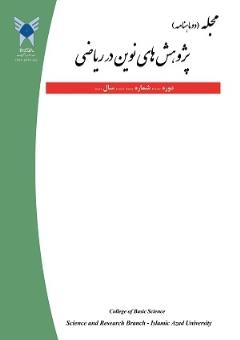بهینه سازی معکوس برای مسئله برنامه ریزی کسری خطی با متغیرهای تصمیم کراندار
محورهای موضوعی : تحقیق در عملیات
1 - گروه رياضي کاربردي (تحقيق در عمليات)، واحد کرمان، دانشگاه آزاد اسلامي، کرمان، ایران
کلید واژه: Bounded variables, Inverse Optimization, Linear fractional programming, Complementary slackness conditions,
چکیده مقاله :
بهینه سازی معکوس یکی از مطالعات نوین در مباحث تحقیق درعملیات است که در سه دهه اخیر مورد توجه محققان قرار گرفته است. در واقع، هدف بهینهسازی معکوس تعدیل مقادیر پارامتری از یک مسئله برنامهریزی ریاضی است، تا یک نقطه شدنی مفروض از آن مسئله به بهینگی برسد. اگر این امر امکانپذیر باشد، آنگاه باید مقادیر پارامتری که نیازمند کمترین تعدیل هستند، را پیدا نمود. در این مقاله، شاخهای از بهینه سازی معکوس برای مسئله برنامه ریزی کسری خطی با متغیرهای تصمیم کراندار مورد بررسی قرار میگیرد، که کاربردهای وسیعی در حیطه صنعت با هدف بهینه کردن تولید دارند. برای انجام این کار، از روابط دوگان و شرایط مکمل زائد مسائل برنامهریزی خطی استفاده میگردد. سپس، شرایطی که یک جواب شدنی، توانایی بهینه شدن توسط تعدیل مقادیر پارامتری تابع هدف را داشته باشد، بیان و مورد بحث و بررسی قرار میگیرد. سرانجام، یک مثال عددی از روش پیشنهادی با تحلیل کامل ارائه میگردد.
Inverse optimization is a modern study in operation research topics that is taken into consideration of researchers in recent three decades. In fact, the purpose of inverse optimization is adjustment in the parameter values of a mathematical programming problem until a given feasible point of those problem arrives to optimality. If this is possible, then those parameter values be must found that require minimum adjustments. In this paper, a branch of the inverse optimization for linear fractional programming problem with bounded decision variables is investigated that have wide applications in industrial area in order to optimize production. To this end, the duality relations and complementary slackness conditions of linear programming problems are used. Next, the conditions for a feasible solution, in order to be optimized by adjusting parameter values of the objective function, are stated and discussed. Finally, a numerical example of the proposed method with complete analysis is presented.
[1] Burton, D., Toint, Ph. L., On an instance of the inverse shortest paths problem. Mathematical Programming, 53(1992), 45–61.
[2] Burton, D., Toint, Ph. L., On the use of an inverse shortest paths algorithm for recovering correlated costs. Mathematical Programming, 63(1994), 1–22.
[3] Zhang, J., Ma, Z., Yang, C., A column generation method for inverse shortest paths problems. ZOR Mathematical Methods of Operations Research, 41(1995), 347–358.
[4] Zhang, J., Liu, Z., Ma, Z., On the inverse problem of minimum spanning tree with partition constraints. ZOR Mathematical Methods of Operations Research, 44(1996), 171–188.
[5] Sokkalingam, P. T., Ahuja, R., Orlin, J.B., Solving inverse spanning tree problems through network flow techniques. Operations Research, 47(1999), 291–298.
[6] Zhang, J., Liu, Z., Calculating some inverse linear programming problems. Journal of Computational and Applied Mathematics, 72(1996), 261– 273.
[7] Zhang, J., Liu, Z., A further study on inverse linear programming problems. Journal of Computational and Applied Mathematics, 106(1999), 345–359.
[8] Yang, C., Zhang, J., Ma, Z., Inverse maximum flow and minimum cut problems. Optimization, 40(1997), 147–170.
[9] Zhang, J., Cai, nM.C., Inverse problem of minimum cuts. Mathematical Methods of Operations Research, 47(1998), 51–58.
[10] Ahuja, R.K., Orlin, J.B., Inverse optimization. Operations Research, 49(2001), 771–783.
[11] Ahuja, R.K., Orlin, J.B., Combinatorial algorithms for inverse network flow problems. Networks, 40(2002), 181–187.
[12] Amin, G., R., Emrouznejad, A., Inverse Linear Programming in DEA. International Journal of Operations Research, 4(2) (2007), 105-109.
[13] Sadri, S., Rostamy- Malkhalifeh, M., Shoja, N., Inverse Linear Programming in Cost Efficiency and Network. Advances and Applications in Statistics, 51(2017), 131-149.
[14] Sadri, S., Rostamy-Malkhalifeh, M., The Calculation of the output price vectorby applying reverse linear programming: The novel approach in DEA. Journal of New Researches in Mathematics, 4(16) (2019), 55-68.
[15] Zhang, J., Liu, Z. Solving a class of inverse Qp problems by a smoothing Newton methode. Journal of Computational Mathmathics, 27(6) (2009), 787-801.
[16] Zhang, J., Xu, C., Inverse optimization for linearly constrained convex separable programming problems. European Journal of Operational Research, 200(2010), 671–679.
[17] Hladik, M., Generalized linear fractional under interval uncertainty. European Journal of Operational Research, 205(1) (2010), 42-46.
[18] Jain, S., Arya, N., Inverse linear fractional programming: A new approach. Journal of Computer and Mathmathical Sciences, 3(5) (2012), 542-547.
[19] Jain, S., Arya, N., On Inverse Linear Fractional Programming Problem. European Journal of Mathematical Sciences, 2(3) (2013), 320-328.
[20] Charnes, A., Cooper, W., W., Programming with linear fractional functionals. Naval Reserch Logistics Quarterly, 9(1962), 181-186.
[21] Murty KG., Linear Programming. John Wiley & Sons, New York, 1983.
[22] Bazaraa, Mokhtar, S., John J., Jarvis, Hanis, D., Sherali, Linear programming and network flows. John Wiley & Sons, 1990.


